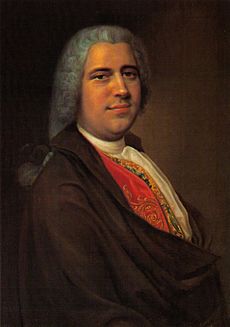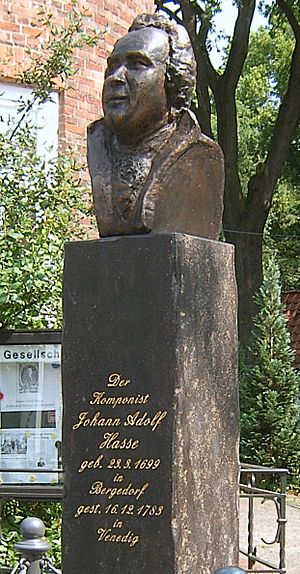Johann Adolph Hasse facts for kids
Quick facts for kids
Johann Adolph Hasse
|
|
|---|---|
 |
|
| Born |
Bergedorf near Hamburg
|
| Baptised | 25 March 1699 |
| Died | 16 December 1783 (aged 84) Venice
|
| Era | Baroque |
| Spouse(s) | Faustina Bordoni |
Johann Adolph Hasse (born 1699 – died 1783) was a very famous German composer, singer, and music teacher in the 1700s. He was incredibly popular during his lifetime. Hasse was best known for writing many operas, which are plays set to music. He also wrote a lot of sacred music, which is music for church.
Hasse was married to a famous singer named Faustina Bordoni. He was also good friends with a writer named Pietro Metastasio, who wrote the stories (called libretti) for many of Hasse's operas. Hasse was a very important person in the development of opera seria (serious opera) and music in the 18th century.
Contents
Starting His Music Career
Johann Adolph Hasse was born in a town called Bergedorf, near Hamburg, Germany. His family had been church organists for three generations. This means they played the organ in churches for a long time.
Hasse started his career as a singer. In 1718, he joined the Hamburg Oper am Gänsemarkt, which was an opera house. He sang as a tenor, which is a type of male singing voice. In 1719, he got a singing job at the court of Brunswick. His first opera, Antioco, was performed there in 1721. Hasse even sang in that show himself!
Hasse probably left Germany around 1722. For about six or seven years in the 1720s, he lived mostly in Naples, Italy. In 1725, his serenata (a type of musical performance for special occasions) called Antonio e Cleopatra was performed in Naples. Famous singers like Farinelli and Vittoria Tesi sang the main parts.
This work was a big success. It led to Hasse getting many requests to write music for Naples's opera houses. It also helped him meet Alessandro Scarlatti, who became his teacher and friend. Hasse even changed his musical style to be more like Scarlatti's.
Hasse became very popular in Naples. He was extremely busy writing music. During this time, he wrote his only full opera buffa (a funny opera) called La sorella amante. He also wrote several intermezzi (short, funny musical pieces) and serenatas. In 1730, he visited the Venetian Carnival in Venice, where his opera Artaserse was performed. The story for this opera was changed a lot, and Farinelli sang a main role. Farinelli later sang two of Hasse's songs from this opera every night for ten years for the King of Spain!
Working in Dresden and Venice
In 1730, Hasse married Faustina Bordoni. He was also given the job of Kapellmeister (music director) at the Dresden court in Germany. He didn't arrive in Dresden until July 1731. Earlier that year, he had been in Vienna, making sure his oratorio (a large musical work for voices and orchestra, usually based on a religious story) Daniello was performed.
Soon after Hasse and Faustina arrived in Dresden, Faustina sang for the court. In September, Hasse's opera Cleofide was performed for the first time. It's possible that the famous composer J. S. Bach attended this performance. Bach's son, C. P. E. Bach, said that Hasse and his father became good friends around this time. The King of Poland and Saxony, Augustus II the Strong, gave Hasse the important title of Royal-Polish and Electoral-Saxon Kapellmeister.
In October, Hasse left Dresden to direct his new operas in Turin and Rome. He also wrote music for theaters in Venice. By late 1732, Hasse was back in Naples. He spent the winter in Venice, where his opera Siroe was performed in a very grand way. In February 1733, King Augustus II the Strong, who was Hasse's patron in Dresden, died. Because the court was in mourning for a year, Hasse was allowed to stay abroad. Many of his sacred works, written for Venice's churches, come from this time.
Hasse was in Dresden for most of 1734. But from 1735 to 1737, he was in Italy, mostly in Naples. Faustina sang in the first performance of Tito Vespasiano in September 1735. When Hasse returned to the royal court in Dresden in 1737, he wrote five new operas. But when the court moved to Poland in 1738, he and Faustina went back to Venice, where they were both very popular.
His next stay in Dresden was his longest, from early 1740 to January 1744. During this time, he updated his opera Artaserse, writing new songs for Faustina. He also wrote a couple of original intermezzi. Hasse usually avoided writing funny operas (opera buffa). This was probably because Faustina worried that the singing style needed for opera buffa would hurt her voice.
Life in Dresden: 1744–1763

Between late 1744 and late 1745, Hasse was in Italy. Then he returned to Dresden for a year. Frederick the Great, who was the King of Prussia and loved playing the flute, visited the court in December 1745. It's likely that many of Hasse's flute sonatas and concertos from this time were written for Frederick. The King of Prussia also attended a performance of one of Hasse's Te Deums (a Christian hymn). He even ordered a performance of Hasse's opera Arminio.
Soon after, Hasse visited Venice and Munich. He returned to Dresden in June 1747 to put on his opera La spartana generosa. This opera was performed to celebrate several royal weddings. Around this time, the leadership at Dresden changed. Nicola Porpora was named Kapellmeister, and Hasse was promoted to Oberkapellmeister (chief music director).
In 1748, Hasse performed two of his operas, Ezio and Artaserse, in Bayreuth. This was for the wedding of Princess Elisabeth Fredericka Sophie. The marriage of Princess Maria Josepha of Saxony to the French Prince gave Hasse a chance to travel to Paris in the summer of 1750. His opera Didone abbandonata was performed there.
On March 28, 1750, Hasse presented his last oratorio, La conversione di Sant' Agostino, in Dresden. The story was written by the Duchess Maria Antonia Walpurgis. It was about a sinner becoming a saint. This work was very popular and was performed many times in different cities.
The 1751 Carnival in Dresden was when Faustina stopped performing in operas. Hasse continued to create new operas throughout the 1750s. This included a version of Metastasio's Il re pastore (The Shepherd King), a story that Mozart also used later.
In 1756, the Seven Years' War forced the court in Dresden to move to Warsaw. However, Hasse mostly lived in Italy. He only traveled to Poland to oversee his opera productions. In the autumn of 1760, he moved to Vienna, where he stayed for two years. He returned to Dresden in 1763 and found that much of his home was destroyed. The musical equipment for the court opera was also ruined. Hasse's main supporter in Dresden, King Augustus III of Poland, died soon after. His successor also died quickly and decided that grand musical events at court were not needed. Hasse and Faustina were paid two years' salary but did not receive a pension.
Later Years in Vienna and Venice
In 1764, Hasse traveled to Vienna. The crowning of Joseph II was celebrated with a performance of Hasse's festa teatrale (a theatrical celebration) called Egeria. The story was again by Metastasio. Hasse stayed in Vienna until 1773. Mozart, who was 15 years old, was at a performance of Hasse's Partenope in September 1767. Most of Hasse's operas from this time were also successful in Naples.
Hasse was a favorite of Empress Maria Theresa of Austria. He was almost like the main music director for the court. After his opera Piramo e Tisbe (September 1768), Hasse wanted to stop writing operas. But Maria Theresa asked him to compose one more work, Ruggiero (1771), which also used a Metastasio story. In 1771, when Hasse heard 15-year-old Mozart's opera Ascanio in Alba, he reportedly said: "This boy will cause us all to be forgotten." This was a very wise comment!
Around this time, opera styles were changing a lot. The serious opera style that Hasse and Metastasio used was being challenged by new ideas from composers like Christoph Willibald Gluck. Gluck wanted opera to be simpler and more dramatic. A writer named Charles Burney visited Vienna in 1773 and wrote about this musical debate. He said that Hasse and Metastasio believed in the old way, where the writer and musician were equally important. Gluck and his friends wanted more theatrical effects and simpler music.
Because his music was being challenged by these new ideas, Hasse left Vienna in 1773. He spent the last ten years of his life in Venice. There, he taught music and composed sacred works. Faustina died in November 1781. Hasse himself died just over two years later, in 1783, after suffering from arthritis. He was mostly forgotten after his death. However, a man named F. S. Kandler paid for his gravestone in Venice and wrote a book about Hasse in 1820.
Hasse and Metastasio's Friendship
Hasse's friendship with Metastasio grew stronger over the years. Hasse also grew to appreciate the type of opera stories Metastasio created. At first, Hasse changed Metastasio's stories a lot when he set them to music. But Frederick the Great and Francesco Algarotti encouraged Hasse to respect Metastasio's original works more.
In the early 1740s, Hasse started using Metastasio's stories without changing them. His personal relationship with Metastasio also got much better. In a letter from March 1744, Metastasio wrote that he saw Hasse as a father, husband, and friend. He said these qualities, along with Hasse's talent and good behavior, made him admire Hasse even more.
In the years that followed, Hasse rewrote some of his earlier works that used Metastasio's stories. This time, he paid close attention to what the poet originally intended. In the 1760s, when Metastasio wrote new stories, Hasse was usually the first composer to set them to music. Charles Burney wrote that Hasse and Metastasio were like "two halves" of a whole. He said they both had true genius, good taste, and good judgment.
Hasse's Musical Style
A musician named Giovanni Battista Mancini called Hasse the "father of music." Hasse was incredibly popular as a leader in serious Italian opera during the 1700s. However, after he died, his fame greatly decreased. His music was mostly not performed, except for some of his sacred works. His operas, in particular, were forgotten. They only started to be performed again towards the end of the 20th century. This was because Gluck's new ideas changed opera away from Hasse's style.
During his time, Hasse's music was known for its beautiful melodies and singing style. Burney said that Hasse was better than all other opera composers, just as Metastasio was better than all other opera writers.
Hasse was also very careful about choosing the right key for his music. Different keys were used to show different emotions. For example, he used the key of A for loving feelings. For noble or royal feelings, he used C and B flat. For scary or supernatural music, he often used C and F minor. Most of his songs started in a major key. They would switch to a minor key for a middle section, then return to the major key. As his career went on, his songs became longer, but he always focused on creating beautiful melodies.
Today, the Johann Adolph Hasse Museum in Hamburg is dedicated to his life and work.
Works by Hasse
See also
 In Spanish: Johann Adolf Hasse para niños
In Spanish: Johann Adolf Hasse para niños


